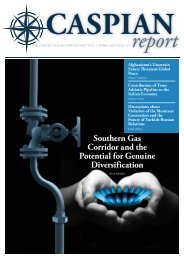You also want an ePaper? Increase the reach of your titles
YUMPU automatically turns print PDFs into web optimized ePapers that Google loves.
term contracts to deliver at least 50<br />
bcm per year through 2030. 6 China<br />
is therefore becoming a major competitor<br />
for international supplies<br />
of LNG, but several factors could<br />
limit the scope of this transformation,<br />
or change its spin. The first is<br />
the actual pace of the Chinese final<br />
demand, since current assumptions<br />
are based on the strong long-term<br />
growth of the Chinese economy, a<br />
trajectory which is far from certain.<br />
Even assuming a massive increase<br />
of final demand, another threat to<br />
LNG demand is looming: competition<br />
from piped gas. Unlike Japan<br />
and South Korea, China can rely<br />
also on imports via pipeline, arriving<br />
from three sources: Central Asia,<br />
Myanmar and Russia. Pipelines running<br />
from Turkmenistan to Western<br />
China are the most important, with<br />
a capacity of 30 bcm per year and<br />
an undergoing expansion up to 80<br />
bcm per year. In addition, a smaller<br />
pipeline is linking offshore field in<br />
Myanmar with Southern China, with<br />
a maximum capacity of 12 bcm per<br />
year. Eventually, after May <strong>2014</strong><br />
agreements with Gazprom, a brand<br />
new pipeline will connect Eastern<br />
Siberia with North-eastern China,<br />
with a capacity of approximately 40<br />
bcm per year by 2020. All in all, by<br />
the beginning of the next decade, the<br />
Chinese gas system will boast an annual<br />
import capacity of more than<br />
150 bcm via pipeline.<br />
EVEN ASSUMING A MASSIVE INCREASE OF FINAL DEMAND,<br />
ANOTHER THREAT TO LNG DEMAND IS LOOMING:<br />
COMPETITION FROM PIPED GAS.<br />
Even considering an adequate level<br />
of spare capacity, the combined import<br />
capacity will exceed Chinese<br />
demand at least until the beginning<br />
of the 2020s. This situation will affect<br />
the global market; LNG exporters<br />
will have to compete with both<br />
other LNG producers and with exporters<br />
of piped gas. Unlike the current<br />
situation, wherein Japanese and<br />
South Korean importers lack alternative<br />
sources and are forced to pay<br />
a high price for LNG, major consumers<br />
will have more market power. As<br />
a consequence, current price differentials<br />
– up to 100% – between<br />
Eastern Asian markets and other<br />
markets are likely to shrink.<br />
India will also play a smaller though<br />
still relevant role in the evolution<br />
41<br />
CASPIAN REPORT, FALL <strong>2014</strong><br />
6.<br />
See EIA, <strong>Report</strong>: China, 04/02/<strong>2014</strong> update.










